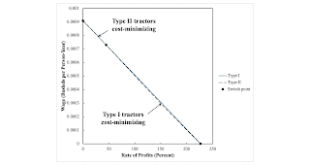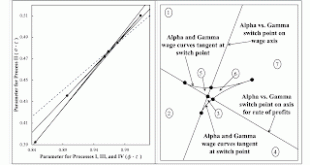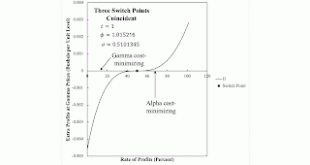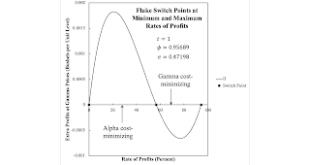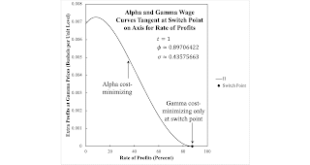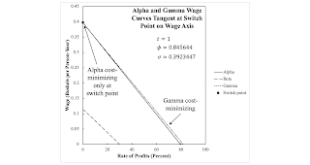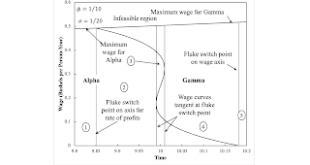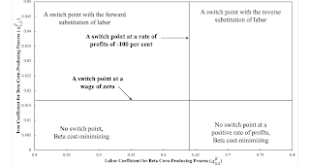Table 1: Lower Rate of Profits around a Switch Point Tradional Marginalist Story'Perverse' Marginalist Story Traditional Austrian StoryGreater net output per workerSmaller net output per worker More roundabout techniqueMore roundabout technique Switch pt. in region 2, 1st in region 52nd switch point in region 3, 2nd in region 6 'Perverse' Austrian StoryGreater net output per workerSmaller net output per worker Less roundabout techniqueLess roundabout technique 1st in region 3, 1st and 3rd in...
Read More »Double Fluke Cases For Triple-Switching In The Corn-Tractor Model
Figure 1: Wage Curves for an Example With Tractors Lasting One and Two Years 1.0 Introduction This post presents two examples in the corn-tractor model. These examples are double fluke cases. Each has three switch points. One is on the wage axis, and another is on the axis for the rate of profits. Perturbations of parameters of each example can result in triple-switching. The corn-tractor model is a fixed capital model, an adaption of the Samuelson-Gargenani model. The consumption...
Read More »The Emergence of Triple Switching and the Rarity of Reswitching Explained
I have written up a series of post as a research paper: first post, second, third, fourth, fifth, sixth, seventh. Here I present the abstract and most of the introduction. Abstract: Empirical research indicates that the reswitching of techniques, as well as multiple switching with more switch points, is rare. This article explores parameter spaces in the analysis of the choice of technique to suggest why reswitching and triple-switching might be hard to find in empirical data. An example...
Read More »Recap For A Triple -Switching Example
Figure 1: Actual and Stylized Partitions of Parameter Space with Triple-Switching This post is a continuation of this series of posts. The partitioning of the parameter space by fluke switch points in these posts can be combined into one picture. The left pane in Figure 1 illustrates. The dashed line is a ray from the origin, discussed below. I find this complete picture for this example hard to perceive by eye. The right pane provides a highly stylized presentation of the partitions,...
Read More »A Sixth Double-Fluke Switch Point For A Triple-Switching Example
Figure 1: Extra Profits at Gamma Prices for the Sixth Double-Fluke Switch Point This post is a continuation of this series of posts. In the last double-fluke case, the three switch points between Alpha and Gamma coincide as a ingle switch point. Figure 1 illustrates, while Figure 2 depicts how the parameter space is partitioned around this double-fluke case. Region 7, in which one switch point occurs, is connected. At the point corresponding to the double-fluke case, the two boundaries...
Read More »A Third Double-Fluke Case For A Triple-Switching Example
Figure 1: Extra Profits at Gamma Prices for the Third Double-Fluke Switch Point This post is a continuation of this series of posts. The next double-fluke case to be considered arises for parameters on intersection of the upper and lower boundaries of regions 3 and 5. Figure 1 illustrates this case, while Figure 2 depicts local perturbations of this double-fluke case. Perturbations that lead to either of the switch points at the extremes of the rate of profits no longer being at a feasible...
Read More »A Second Double-Fluke Switch Point For A Triple-Switching Example
Figure 1: Extra Profits at Gamma Prices for the Second Double-Fluke Switch Point This post is a continuation of this series of posts. A switch point in which wage curves are tangent on the axis for the rate of profits is a double-fluke case symmetrical to the double-fluke case in the previous post. As shown in Figure 1, this case arises in this example as well. The roles of the Alpha and Gamma techniques are reversed. Alpha is always cost-minimizing, while Gamma is cost-minimizing only at...
Read More »A Double-Fluke Switch Point For A Triple-Switching Example
Figure 1: The Wage Frontier for a Double-Fluke Switch Point This post is an expansion of a previous one. That post defines the technology and the price system for the three techniques conprising the technology. In Alpha, labor and corn inputs are used to produce corn. Beta and Gamma are more roundabout. In each, Labor and corn are first used to make a machine that lasts two years and can be used to produce corn each year. In Beta, the machine is discarded after being operated one year. The...
Read More »A 1D Diagram For A Triple-Switching Example
Figure 1: Triple Switching with Strucutral Economic Dynamics1.0 Introduction I have been using fluke switch points to partition two-dimensional slices of parameter spaces. I know, I think, how reswitching can appear and disappear. But I am confused how more switch points can appear. So this post is a start on exploring a triple-switching example. I have stumbled upon two examples of triple-switching, so to speak. I have not yet replicated Steedman's claim that triple-switching can arise...
Read More »Three Examples For The Cambridge Capital Controversy
Figure 1: A Parameter Space1.0 Introduction I have been reconstructing some of my examples. The first example in this post is from here. I am thinking of writing a draft article, as mentioned here. While I am at it, I thought I would also work through the examples in Garegnani (1966) and Bruno, Burmeister & Sheshinski (1966), both from the symposium in the Quarterly Journal of Economics of that year. 2.0 The Emergence of the Reverse Substitution of Labor This section presents an...
Read More » Heterodox
Heterodox

